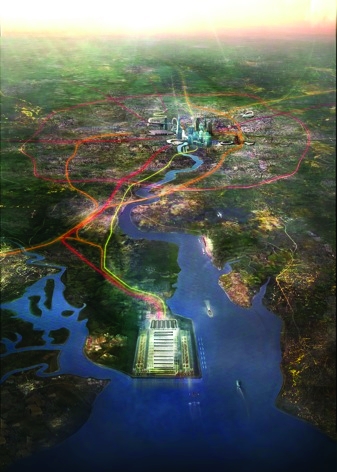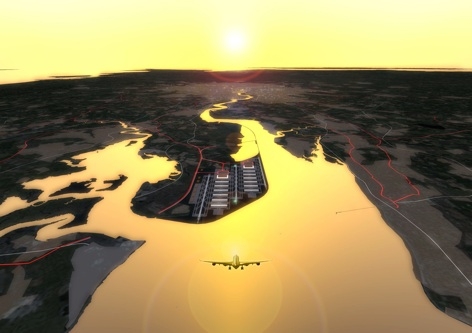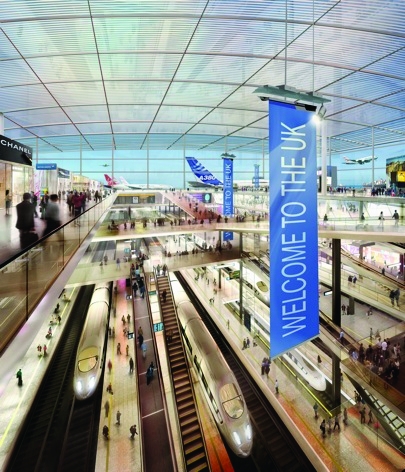Thames Estuary airport is back on the agenda, thanks to opposition to expanding Heathrow and enthusiasm from the mayor of London, Boris Johnson. As the government’s Airports Commission considers the best way of expanding the UK’s air travel capacity (although they’re mainly looking at south-east England), we put your questions to two of the
teams who have put forward proposals for a new hub in the Thames Estuary.
• The Thames Reach Airport consortium has been working for more than 10 years on plans for a privately funded £29bn two-to-four-runway airport on reclaimed land on the Hoo peninsular that would also include the Metrotidal project to build a tunnel under the estuary providing new road and rail loops, flood defences and tidal energy generation.
• Architecture firm Foster + Partners has proposed building a privately funded £24bn four-runway ‘Thames Hub’ airport on a raised platform on the Isle of Grain in the model of its artificial island airport in Hong Kong, linked to London via several rail lines, including HS1 and Crossrail.
Why would a Thames Estuary airport be preferable to expanding our existing infrastructure at Heathrow, Gatwick and/or Stansted, given the considerable extra costs involved and the extra time it will add to passengers’ journeys?
Foster + Partners: For many passengers using high-speed rail, a Thames Estuary airport could be reached in less time than it currently takes to get to Heathrow and the £24bn cost of a brand-new airport is less than two new runways at Heathrow. [Heathrow estimates building a third runway would cost £14bn–£18bn, of which £4bn–£6bn might come from government. A fourth runway would cost a further £8bn–£14bn.] Passengers would be able to take a direct train from St Pancras to the new airport in approximately 26 minutes using HS1; and journey times for passengers from Birmingham or Manchester would be drastically reduced. Heathrow requires major surface access improvements in an already congested area. Gatwick is as far, and Stansted further, than Thames Hub and they would both require substantial surface access improvements.

There are many other advantages to a four-runway Thames Estuary airport, not least the opportunity to relieve five million Londoners of the noise, pollution and dangers of flight paths over the capital. Without the constraints of an urban site, the airport would be more cost-effective to build and, unlike Heathrow, it can operate 24 hours a day, due to the sparsely populated area. It can open with capacity for 110 million passengers per annum within 16 years — the same timeframe as a third Heathrow runway, which would be full within a decade of opening. The proposed site is also strategically located close to the south-east’s major ports to enable the successful economic integration of rail, sea and air freight.
Thames Reach: Thames Reach Airport with the surface access provided by Metrotidal Tunnel will have a much larger catchment area and better connectivity for lower cost than expanding Heathrow, Stansted or Gatwick. The longer travel distance from northwest and west of London to the estuary location is more than made up by the more efficient travel time airside and landside when passing through the purpose-designed, new-build airport. Despite the billions proposed to expand and improve the capacity at Heathrow, the dispersed arrangement of gates between widely separated main terminals and two runway infields results in an inefficient airport configuration with higher travels times. Even with a modern mass-transit people-mover, a distance of up to 7.8km between train and satellite will result in substantially longer average transit times than a purpose-designed system.

At Thames Reach Airport, with the airport station directly beneath and beside the airport terminals, a maximum of 2.7km from station to satellite on a single passenger transit axis and a compact airfield with offset runways, there are savings of 30 minutes on average when passing through the airport system landside and airside, resulting in a 10-minute comparative proximity benefit. If the route for HS2 did not go out of its way to help Heathrow, the benefit of Thames Reach Airport would be even better. With a site to the east of London close to HS1, the comparative proximity of Thames Reach Airport is also much better than Heathrow for all areas northeast, east and south from Central London, including northern Europe as far as Paris, Brussels and Amsterdam.
Why combine the airport with the Metrotidal Tunnel project when this will increase the costs even further?
TR: Metrotidal Tunnel, integrated with new flood defences and tidal power, is funded independently by the private sector and these costs do not fall on the aviation agenda. So, contrary to increasing the aviation costs, Metrotidal Tunnel substantially reduces the residual cost of the new hub airport, enabling it to be funded by the aviation market and private sector. Metrotidal Tunnel also provides the necessary surface access improvements for both passengers and employees, including shorter routes from Cambridge, Ipswich and Gatwick/Crawley that avoid inner-London congestion so these areas will all be within the one-hour catchment using conventional rail services. The stopping service on an extended Crossrail and express rail services to St Pancras and Waterloo would also extend the one-hour catchment to surrounding areas of London and the West End.
What would be the biggest engineering challenges involved in the project and how do you intend to overcome these?
FP:Although it is a large project, it is relatively straightforward in engineering terms. The construction of the airport platform would use well-established civil engineering technologies, which have been used to build major airports on reclaimed land elsewhere in the world, such as Chek Lap Kok airport in Hong Kong. In Europe, similar reclaimed land techniques have been used extensively in Holland for many decades.

TR:The biggest civil engineering challenges are: the construction of the Metrotidal pool impoundment and weirs so that they are environmentally and hydrodynamically neutral for the Thames tideway while providing maximum flood-storage capacity and tidal pumped-storage output; and the subsequent timely construction of the airport platform within the pools. The configuration for the pool impoundment and weirs will be tested and refined on numeric models of the Thames tideway. This will optimise the flood-defence benefits during storm surges, while managing flow rates and sedimentation during normal tidal cycles, and provide a stable self-scouring system that requires no more maintenance dredging than at present.
Why have you chosen the site your plans are based on? Why has the 1970s plan to build at Maplin Sands not been pursued?
FP:The 2003 South East and East of England Regional Air Services Study (SERAS) study supplanted the work done on Maplin Sands and showed an inner-estuary location as the optimal site. We refined this work and settled on a proposal to the west of Maplin and to the east of Cliffe, where the impact on people and wildlife habitats could be minimised. Maplin still has a large amount of unexploded ordnance, the north of the Thames is more heavily populated and it is further away in terms of surface access. The Isle of Grain also emerged as the best location in the mayor of London’s recent assessment of 16 different airport sites in the south east.
TR:For the Metrotidal integration, the volume of a flood-storage system would have to be very much larger at Maplin to provide the same reduction of flood risk upstream. Similarly, the pools for a tidal power plant at Maplin, with a lower tidal range, would have to be very much larger to provide the same output. As a result the flood-storage and tidal-power functions would not be viable. For Maplin to provide benefits for the Thames Estuary region, the road and rail umbilical to the airport would need to loop back under the estuary to the Isle of Grain. Not only would this tunnel be more than twice as long but the associated road and rail orbitals around the estuary would be very much longer, which together trebles the construction costs of the airport surface access and creates longer journey times while significantly reducing the wider benefits.
How would the airport impact on tidal defences and flood risk and what measures do your plans include to mitigate against this?
FP: The airport itself does not change the nature of wider flood risks, but the development is an opportunity to integrate future flood protection with a wider infrastructure strategy. The Thames Estuary 2100 report from the Environment Agency looks closely at the impact on flood defences and habitat loss in the light of thermal expansion in the oceans and storm severity. This validates earlier work that we based our designs on to found the base level for the airport platform 7m above sea level, negating any flood risk.
TR: Metrotidal Tunnel is designed to provide the next generation of London’s flood defences without requiring a permanent barrier across the shipping channel, by using the controlled flood-storage capacity of the pools. The pools would provide a throttle for storm surges and a reduction in tidal squeeze (loss of intertidal areas due to rising sea levels) upstream while not throttling the tideway in normal tidal cycles, and provide tidal-pumped-storage renewable energy output to offset transport energy demands. They would also reduce the cost of the tunnel by increasing the proportion of cut-and-cover areas protected from the tides during construction, and create a balance of materials on site for raising the airport platform, while minimising the embodied energy and carbon audit of the platform construction.
How much of a threat is the sunken US warship SS Richard Montgomery that lies in the estuary and still contains around 1,400 tonnes of explosives, and what measures would you include to protect against the potential tsunami that may occur if the explosives were detonated?
FP:As the ship is close to one of Europe’s busiest shipping lanes, it is already closely monitored by the Maritime and Coastguard Agency — its latest report stated that the hull is reasonably stable, but the explosives are degrading. We believe there will come a point when the risks in doing nothing are greater than the risks involved in a carefully planned intervention, irrespective of whether or not the airport is built. At this stage, we are proposing further government-led studies to determine the future of the ship.
TR:The SS Richard Montgomery falls well outside the Metrotidal Tunnel and Thames Reach Airport impoundment. However, the risk of explosion should not be allowed to influence such an important infrastructure decision for the UK so there is a case for the Environment Agency to tender solutions and resolve the matter now. Solutions include raising a blast levee by pumping sediment around the north, west and south sides of the wreck and laying time-co-ordinated directional explosive charges to direct blast and associated waves towards the outer estuary. The Metrotidal pool impoundment would protect the airport from residual wave propagation westwards.
What specific measures would you take to replace the environments for internationally important breeding and migratory marine and bird species that will be lost during construction, and to where will the species be displaced?
FP:These natural habitats are already under threat from rising sea levels and storm surges yet there is limited funding available to protect them. An airport could be a catalyst for conservation initiatives, not only to mitigate the impacts of the airport development but to address wider habitat loss. Existing schemes, such as Wallasea Island have shown that estuary birds will readily use newly created habitats, so long as conditions are suitable.
TR: The loss of intertidal area within the pools is offset by intertidal areas upstream that will be protected from tidal squeeze by the tunnel and airport system. Similarly the area of low-lying freshwater meadows and creeks within the pools is offset by the substantial freshwater habitat area upstream that will benefit from improved flood protection. There are two strategies for providing replacement intertidal area and low-lying land. The first is to determine sites where managed retreat would be an economical solution to provide new designated intertidal areas without loss of existing sites. The second is to research sites in the outer estuary away from the airport platform where a stable new island habitat surrounded by intertidal areas can be formed by raising an impoundment on or beside existing shallows using tidal pumped-storage energy from the London Array.
One reader raised the prospect of installing nearby photobioreactors to capture carbon emissions from the airport that produce algae for sale as fishmeal. Do you think it would be worth pursuing this idea and how easily could it be done?
TR:Prevailing winds indicate that the carbon emissions and associated NOX contours will mostly fall over the open estuary to the northeast of the airport platform, where they will be rapidly dispersed by the winds and tides. If analysis can demonstrate a significant proportion of the carbon emissions can be captured in this area, there may be a case for exploring use of photo-bioreactors although concerns will arise from the associated capture of pollutants that would otherwise be dispersed. This area may also be suitable for the generation of energy from tidal-stream devices to compliment the predominant and more secure tidal-head output from the pools. Other wind directions will direct the airport emissions over the pools where for similar reasons there may be a case to explore the use of photo-bioreactors, with similar limitations.




Red Bull makes hydrogen fuel cell play with AVL
Many a true word spoken in jest. "<i><b>Surely EVs are the best solution for motor sports</b></i>?" Naturally, two electric motors demonstrably...